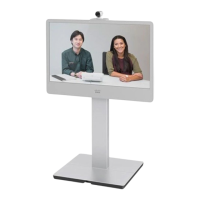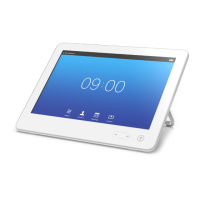D15119.02 MX700 and MX800 Administrator Guide TC7.2, AUGUST 2014. www.cisco.com — Copyright © 2014 Cisco Systems, Inc. All rights reserved.
98
Cisco TelePresence MX700 and MX800 Administrator Guide
SIP settings
SIP ANAT
ANAT (Alternative Network Address Types) enables media negotiation for multiple addresses
and address types, as specified in RFC 4091.
Requires user role: ADMIN
Value space: <Off/On>
Off: Disable ANAT.
On: Enable ANAT.
Example:
SIP ANAT: Off
SIP AuthenticateTransferror
Not applicable in this version.
SIP ListenPort
Turn on or off the listening for incoming connections on the SIP TCP/UDP ports. If turned off, the
endpoint will only be reachable through the SIP registrar (CUCM or VCS). It is recommended to
leave this setting at its default value.
Requires user role: ADMIN
Value space: <Off/On>
Off: Listening for incoming connections on the SIP TCP/UDP ports is turned off.
On: Listening for incoming connections on the SIP TCP/UDP ports is turned on.
Example:
SIP ListenPort: On
SIP PreferredIPMedia
Define the preferred IP version for sending and receiving media (audio, video, data). Only
applicable when both Network IPStack and Conference CallProtocolIPStack are set to Dual, and
the network does not have a mechanism for choosing the preferred IP version.
Requires user role: ADMIN
Value space: <IPv4/IPv6>
IPv4: The preferred IP version for media is IPv4.
IPv6: The preferred IP version for media is IPv6.
Example:
SIP PreferredIPMedia: IPv4
SIP PreferredIPSignaling
Define the preferred IP version for signaling (audio, video, data). Only applicable when both
Network IPStack and Conference CallProtocolIPStack are set to Dual, and the network does not
have a mechanism for choosing the preferred IP version. It also determines the priority of the A/
AAAA lookups in DNS, so that the preferred IP version is used for registration.
Requires user role: ADMIN
Value space: <IPv4/IPv6>
IPv4: The preferred IP version for signaling is IPv4.
IPv6: The preferred IP version for signaling is IPv6.
Example:
SIP PreferredIPSignaling: IPv4
SIP OCSP Mode
Not applicable in this version.
SIP OCSP DefaultResponder
Not applicable in this version.

